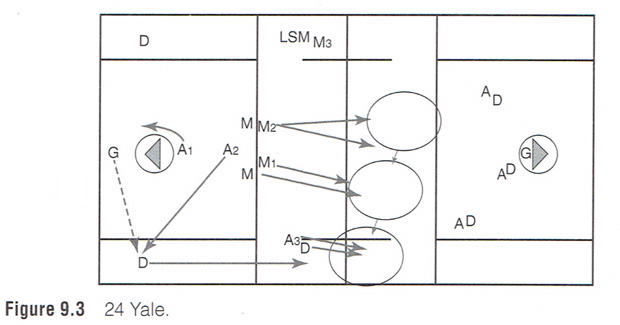| Rides - 24 Zone and 24 Yale |
| By: Jack Kaley and Rich Donovan
Originally Published in: Lacrosse Essentials Provided by: Human Kinetics Use the 24 zone to teach the basics of riding. It incorporates the recovery from offense to defense, the cutoff of all breakouts, the pressure and pursuit angles, and sliding zone principals. The 24 zone comes from the formation of two attackmen (2) down and the three midfielders and third attackman (4) zoning at the midline. Use this ride on all shots and dead-ball clears. The key to success on this ride and all rides is the midfielders cutting off their man on the initial breakout after a shot. The crease attackman plays the goalie, and his main responsibility is to prevent breakout passes to the midfielders or defensemen upfield. The other two attackmen immediately drop back near the top of the restraining line. Their responsibility is to play the deepest defenseman on their side of the field. If the deepest defenseman is at the midfield line at the middle of the field, they both initially play him. One will lock onto him and the other will cover the first pass to one of the low defensemen. Once one attackman is playing a long pole at or near the midline, he becomes part of the midfield zone. The four men zoning at the midline are initially covering the man in their zone on the same side of the field that they're playing on. The two attackmen down low are zoning the two remaining defensemen and goalie. Their responsibility is the ball-side man and to press the ball carrier and force as many passes as possible. The other attackman's responsibility is to be deeper than the deepest man (goalie and wing defensemen) on his half of the field. Again, his responsibility is to force as many passes as possible. If it appears that the clearing low defensemen will beat the attackman after a few redirect passes, the four remaining riders zoning at the midline slide and bump to the ball. This is the most difficult technique to teach, but it can be done by repetition and talking until everyone understands what needs to be done. This is why you work on riding in all competitive drills, from 1v1 to 10v10. When the bumping begins, it is important to shut down the two midfielders closest to the ball. You want to force the clearing defenseman to make a pass while he is being pressured by the riding attackman underneath and the midfielder bumping over to pick him up. It's important that the midfielder who is sliding to the ball does so on your offensive side of the field. This way you have two players attempting to trap the clearing defenseman before he gets to the midline. This also allows the three remaining riders in the middle of the field to play deeper than the man they are bumping to without concern about going offside. See figure 9.2.
24 YALE The name for the 24 Yale ride comes from the Yale lock company, not Yale University. In the 24 Yale ride, the high attackman (A3) locks onto his man and goes with him if he goes over the midfield line. Make this adjustment if the clearing long poles are good stick handlers and are beating you on redirect passes or if your midfielders are having a difficult time adjusting their zones to the clearing patterns. The Yale ride is not a zone but a man-to-man ride. The Hugo ride uses a combination of man-to-man and zone techniques. The riding midfielder must play deeper than his man but on the same side of the midline. This is similar to the 24 zone in the initial setup, except you are not in a zone but are locked onto your men after the initial breakout. Use this when one defenseman or more goes over the midfield line or the short poles are cutting down low to clear the ball. The important thing is that your midfielders be locked onto their men. The attackman playing the deepest defenseman also locks on if he goes over the midline. You are riding with two attackmen zoning and chasing the three low clearing opponents (two defensemen and one goalie). See figure 9.3.
|









